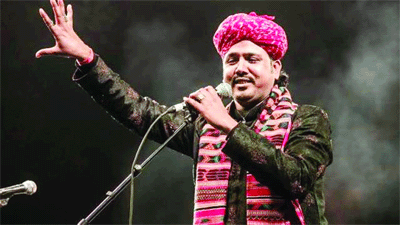Mame Khan launches his debut album, Desert Sessions, the first crowd- funded album created by a Manganiyar musician. By Devi Singh
For somebody who spent his infantile at a place where the basic amenity like electricity was a luxury, becoming an internet sensation was a dream come true. Hailing from a village named Satto, near Jaisalmer in Rajasthan, Mame Khan belongs to the Manganiyar community, known for their energetic style of music, passed on down the generations through the oral tradition. They have continued their legacy seeking the patronage of Rajput rulers. Since generations they have provided musical service to their patrons to receive cattle, camels, goats or cash as gift.
Though they are Muslims, many of their songs are in praise of Hindu deities and celebrate Hindu festivals such as Diwali and Holi. The Manganiyar performers traditionally invoke the Hindu lord Krishna and seek his blessings before beginning their recital. Explaining the relationship between the Muslim Manganiyars singing for the Hindu Rajput kings, Khan says, “Our patrons were Hindu Rajputs who belonged to the Bhati community and believed in Krishna and that’s why we invoke lord Krishna before our recitals.”
He was influenced and tutored by his father, Rana Khan who belonged to the first generation of Manganiyar musicians who left their villages to perform all over India and the world. Rana Khan trained the prodigies of his community to carry on the legacy of oral tradition. “My father mentored around 200 disciples in the Manganiyar community. He used to sing in Hindi, Urdu, Sindhi, Punjabi and Rajasthani. He started training me really early in my childhood. So I’ve lived music all my life from the very beginning. As they say in our community — whenever a Manganiyar child cries, he cries to the notes of music,” gushes Khan.
Khan finally launched his first independent album which he refers to as his dream project. “It was always a dream to come up with my own debut album. I’ve had albums with lots of people in India and abroad but I wanted to cut an album of my own. It took almost an year to come up with it. There are many albums about Manganiyars but not particularly on them, like the langa-Manganiyar volumes. I feel privileged that I have an album in my name,” says Khan.
The album essentially captures the essence and spirit of Rajasthan, digging the roots of folk and Sufi music. There are seven songs in the album which have been reinterpreted with a modern twist. “I’ve rearranged Manganiyar folk songs to suit the urbane listeners by using keyboard and saxophone. The tracks include lolee, Bule Shah, Kesariya Balam, Krishna bhajan among others,” he says. There are 10 other Manganiyars who have worked in the album besides him. The use of khamaycha can be heard throughout the album. The 17-string bowed instrument is made of mango wood. Its rounded resonator is covered with goat skin. Three of its strings are goat intestine while the other 14 strings are steel.
“I’ve used it extensively in the album; it’s a signature instrument of the Manganiyars. It is used in every show of mine. Its sound is very deep like a violin. The instrument is almost dying and many organizations are coming forward to save it from extinction. Initially it used to be made in Ahmedabad but now it’s only made in Jaisalmer by a few carpenters,” tells Khan.
The concept of crowd funding is what gives the album a distinct touch. This is the first time an artist from the Manganiyar community has had a campaign like this. “I always wanted to cut an album but I didn’t know how. I didn’t have money. Someone from my team suggested me to crowd fund. The way Manganiyars sing for their patrons which are maharajas and get supported in return likewise internet is a medium where we got our patrons who supported us because they loved our music,” he explains.
Khan, has experimented a lot with his genre of music with varied collaborations. He has worked with Roysten Abel for The Manganiyar Seduction, Hungarian and Iranian musicians along with Indian artists like, Amit Trivedi with whom he worked on films like luck By Chance and No One Killed Jessica and Coke Studio for MTV. He’s doing a version of Kesariya balam with Midival Punditz and also working on Shankar Mahadevan’s MCM (My Country my Music)
Khan says The Manganiyar Seduction directed by Roysten Abel was one of the greatest experiences of his life. “I learned a lot from Abel. It was a grand show comprising of a group of 50 people including sound engineers, managers and Manganiyar musicians. We had 104 shows all over the world. Initially it was tough to perform for us as we were asked to sit on top of each other. But I would say a Manganiyar can do anything. He can rock anywhere in any circumstance. He will sing in any situation,” says Khan.
Talking about his endeavors to promote the Manganiyar community he says he’s putting in every effort to give his fellow artists exposure. “My entourage consists of 15 Manganiyars who come from different villages and I’m trying to give them as much exposure as I can. We had 10 shows in the month of September alone which is a big thing. I take the fellow Manganiyars to places and concerts with me so that they are encouraged to hold on to their music. I also use the indigenous instruments of our community like, Khamaycha a lot,” he adds.
“I would say folk music is the most powerful of all and we should do everything to keep its passion alive for ages. We should stick to our roots and keep them intact. My ultimate aim is to show the beauty of Rajasthani folk and Sufi music to the world and to promote my community. There are still many hearts to be won,” he concludes.
























